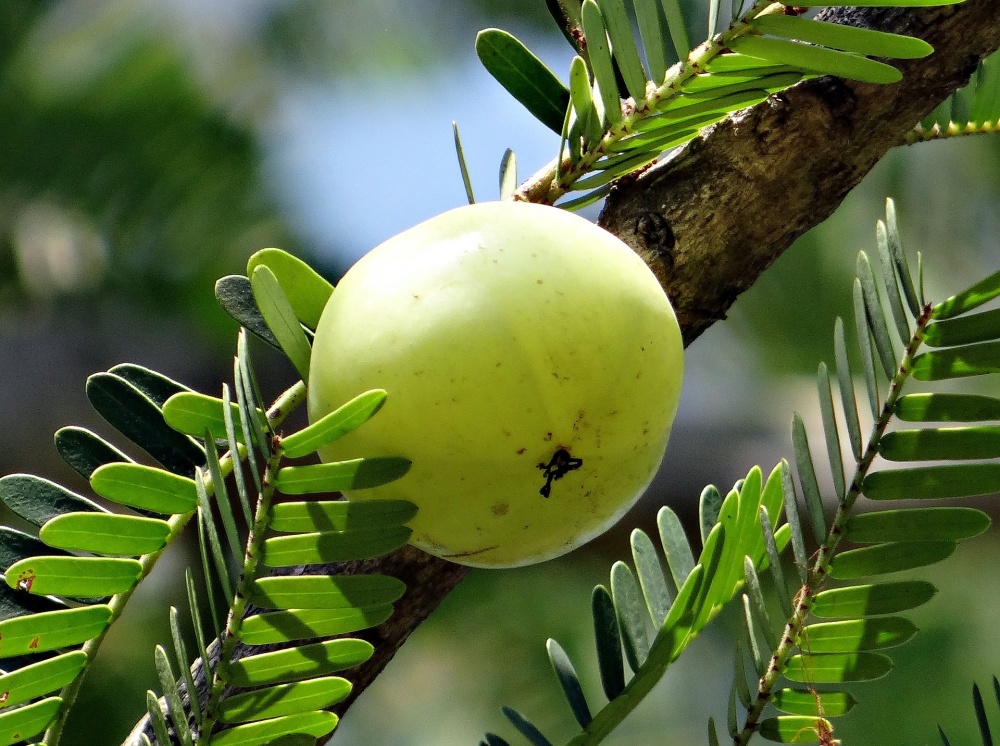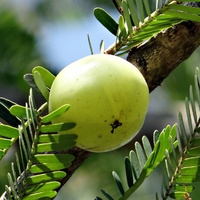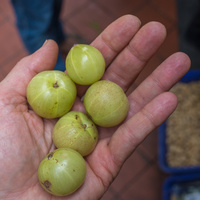Common name: Indian gooseberry
Other common names: Emblic, Malacca tree
Description
Ⅰndian gooseberry or Amla is a fruit-bearing and medicinal tree originating in India and Southeast Asia. Its natural range extends across much of the Indian subcontinent, from the foothills of the Himalayas to Sri Lanka and from Bangladesh, east to Myanmar (Burma), Thailand, Malaysia, Vietnam and southern China.
It is a fast-growing tree and may reach up to 30 m (98 ft), though it is typically 10 to 15 m (32 to 50 ft) tall with a slender, often crooked trunk, fluted at the base supporting a wide-spreading crown. The bark is grey-brown and flaking off in thin pieces, revealing yellow underbark, giving the trunk a mottled appearance.
Leaves are feathery and finely textured, consisting of small dull green elliptical leaves up to 2 cm (0.8 in) long, arranged opposite, in rows along thin branchlets. In the dry season, they fall off the tree to conserve water, leaving the branches bare and exposed until the rainy season. The new leaves emerge soft and pinkish, then harden and become green.
The flowers are tiny and insignificant, greenish or pink and borne either female or male along the branchlets. They bloom in spring, induced by increasing day-length, around the same time the new leaves emerge. The small round fruit that follows are 2 to 3 cm (0.8 to 1.2 in) in diameter, with thin, pale green skin and crisp, very sour pulp surrounding a hard nut. They ripen to yellow-green about six to nine months after fruit-set, usually from autumn to winter.

Photo by sarangib from Pixabay
Use
Even when ripe, the fruit are sour and astringent. They are rarely eaten fresh out-of-hand and are instead traditionally made into preserves, including pickles and relishes or are dried and candied and eaten as a sweet. The pulp is high in vitamin C, reportedly containing about 700 mg per 100 grams of fruit, and rich in antioxidants. Nowadays, it is pureed and dried into a powder marketed as a health food or superfood.
The pulp is also used in pastry fillings, with other fruit in chutneys or is juiced and used as a souring agent in cooking, similar to Tamarind (Tamarindus indica) or to flavour drinks, vinegar, syrups and cordials. It is also high in pectin and therefore ideally suited for making jam.
The wood is reddish, heavy, averaging about 750 kgs per cubic meter (47 lbs per cubic ft), has good natural resistance to rot and decay and is durable under water. However, the logs are mostly poorly formed or small in diameter, which makes sawing them into lumber impractical. When available, it is mainly used for firewood or for making charcoal.
The flowers are observed being actively worked by honeybees. Still, information on its value as a bee-forage and honey tree is limited.
Health use
The fruit pulp is used extensively in traditional Indian or Ayurveda medicine to treat various liver and cardiovascular ailments. 'Triphala', an Ayurveda drug used to treat enlarged liver, ascites, biliousness, chronic dysentery, dyspepsia, constipation and headache, consists of equal parts of dried, powdered Amla, Myrobalan (Terminalia bellirica) and Black myrobalan (Terminalia chebula) fruit.
In vitro studies using ethanol extracts of the pulp have shown a strong cardioprotective effect against doxorubicin-induced cardiotoxicity. 'Doxorubicin' is an important and effective anticancer drug widely used to treat various cancer types. Still, its use is limited by dose-dependent cardiotoxicity.
Climate
Grows naturally in sub-humid to humid subtropical and tropical climates, generally frost-free areas with annual lows of 12 to 25°C, annual highs of 23 to 35°C, annual rainfall of 600 to 4200 mm and a dry season of 8 months or less, extending to 12 months with irrigation or groundwater.
Growing
New plants can be started from seed, but the germination rate is low, and those that are viable fail to germinate after twelve months in storage. Seedlings are also not true-to-type, producing inferior fruit. So selected varieties are best propagated vegetatively, using either cuttings or air-layering (circumposing) techniques.
Different varieties are named after their place of origin or for the size of their fruit. Some of the more widely cultivated include 'Balwant' (an early maturing, heavy bearing variety with large fruit), 'Francis' (a mid-season maturing, moderately bearing variety with large fruit) and 'Chakaiya' (a late-ripening, heavy bearing variety with medium-sized fruit).
Performs best on free-draining clay, loam and sand soils of a moderately acid to alkaline nature, generally with a pH of 5.0 to 8.5, and on sites with full to partial sun exposure. Established trees have good tolerance to drought and alkaline or limestone soils.
Seedling trees start flowering and fruiting when about seven to eight years old, compared to around five years for vegetatively propagated trees. Mature trees yield on average between 100 and 150 kgs (220 and 330 lbs) of fruit annually.
Problem features
It is recorded as escaping cultivation and as a weed of agriculture in Australia. Still, there does not appear to be any record of it anywhere as an invasive species.
Where it grows
References
Books
-
Allen, B. M. 1967, Malayan fruits : an introduction to the cultivated species, Donald Moore Press, Singapore
-
Barwick, M., et al. 2004, Tropical & subtropical trees : a worldwide encyclopaedic guide, Thames and Hudson, London
-
Champion, H. G. & Seth, S. K. 1968, A revised survey of the forest types of India, Natraj Publishers, Dehradun, India
-
Chevallier, A. 2000, Encyclopedia of herbal medicine, 2nd American ed., Dorling Kindersley, New York
-
Dastur, J. F. 1964, Useful plants of India and Pakistan : a popular handbook of trees and plants of industrial, economic, and commercial utility, 2nd ed., D. B. Taraporevala Sons, Bombay
-
Farooqi, A. A. & Sreeramu, B. S. 2004, Cultivation of medicinal and aromatic crops, Hyderabad University Press, Hyderabad
-
Green, C. L. 1995, Natural colourants and dyestuffs : a review of production, markets and development potential, Food and Agriculture Organization of the United Nations (FAO), Rome
-
Groom, N. 1997, The new perfume handbook, 2nd ed., Blackie Academic & Professional, London
-
Hocking, D. 1993, Trees for drylands, International Science Publisher, New York
-
Janick, J., & Paull, R. E. 2008, The encyclopedia of fruit & nuts, CABI Publishing, Wallingford, Oxfordshire
-
Jansen, P.C.M. & Cardon, D. (Editors) 2005, Plant Resources of Tropical Africa, Volume 3 : Dyes and tannins, PROTA Foundation, Backhuys Publishers, Leiden
-
Jex-Blake, A. J. 1957, Gardening in East Africa : a practical handbook, 4th ed., Royal Kenya Horticultural Society, Longmans, Green and Company, London
-
Krishen, P. 2006, Trees of Delhi : a field guide, Dorling Kindersley Publishers, Delhi
-
Little, E.L. Jr. 1983, Common fuelwood crops: a handbook for their identification, McClain Printing Company, Parsons, West Virginia
-
Lorenzi, H. 2006, Brazilian fruits & cultivated exotics (for consuming in natura), Instituto Plantarum de Estudos da Flora, Nova Odessa, San Paulo
-
Luna, R. K 1996, Plantation trees, International Book Distributors, Dehradun, Uttarakhand
-
Macmillan, H. F. 1943, Tropical planting and gardening : with special reference to Ceylon, 5th ed, Macmillan Publishing, London
-
Martin, F. M., et al. 1987, Perennial edible fruits of the tropics : an inventory, U.S. Dept. of Agriculture (USDA), Agricultural Research Service, U.S. Government Printing Office (GPO), Washington, D.C.
-
Martin, F. W & Ruberte, R. M. 1975, Edible leaves of the tropics, U.S. Agency for International Development (USAID), and the Agricultural Research Service, U.S. Department of Agriculture (USDA), Mayaguez, Puerto Rico
-
Morton, J. F. & Dowling, C. F. 1987, Fruits of warm climates, Creative Resources Systems, Winterville, North Carolina
-
National Research Council (Board on Science and Technology for International Development) 1980, Firewood crops : shrub and tree species for energy production (Volume 1), The National Academies Press, Washington D. C.
-
Page, P. E. 1984, Tropical tree fruits for Australia, Queensland Department of Primary Industries (QLD DPI), Brisbane
-
Parrotta, J. A. 2001, Healing plants of peninsular India, CABI Publishing, Wallingford, Oxfordshire
-
Randall, R. P. 2002, A global compendium of weeds, R.G. and F.J. Richardson Press, Melbourne
-
Randall, R. P. 2007, The introduced flora of Australia and its weed status, Cooperative Research Centre for Australian Weed Management, Glen Osmond, South Australia
-
Selvam, V. 2007, Trees and shrubs of the Maldives, Food and Agriculture Organisation (FAO) RAP publication (Maldives), Thammada Press Company Ltd., Bangkok
-
Shanley, P. 2002, Tapping the green market : certification and management of non-timber forest products, Earthscan Publishing, London
-
Sheikh M. I. 1993, Trees of Pakistan, USAID Forestry Planning and Development Project, Pictorial Printers, Islamabad
-
Singh, R. V. 1982, Fodder trees of India, Oxford & IBH Publishing Company, New Delhi
-
Thomson, G. 2007, The health benefits of traditional Chinese plant medicines : weighing the scientific evidence, Rural Industries Research and Development Corporation (RIRDC), Barton, Australian Capital Territory
-
Winter, R. 2009, A consumer's dictionary of cosmetic ingredients : complete information about the harmful and desirable ingredients found in cosmetics and cosmeceuticals, 7th ed, Three Rivers Press, New York
Articles, Journals, Reports and Working Papers
-
Subhadrabandhu, S. 2001, Under-utilized tropical fruits of Thailand, Food and Agriculture Organisation of the United Nations (FAO), Regional Office for Asia and the Pacific (RAPA), Bangkok



